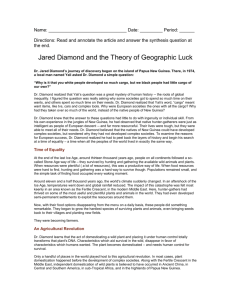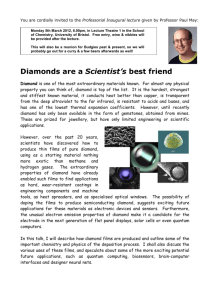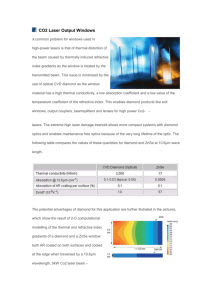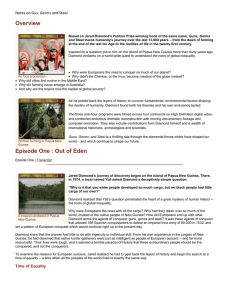Jared Diamond and the Theory of Geographic Luck
advertisement
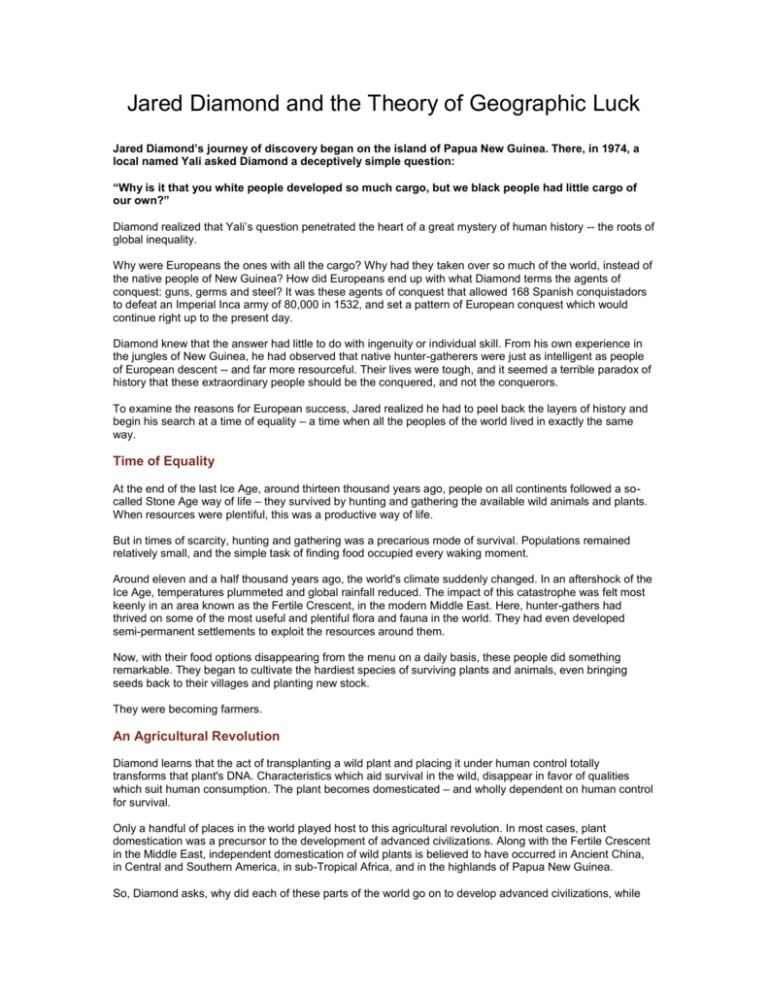
Jared Diamond and the Theory of Geographic Luck Jared Diamond’s journey of discovery began on the island of Papua New Guinea. There, in 1974, a local named Yali asked Diamond a deceptively simple question: “Why is it that you white people developed so much cargo, but we black people had little cargo of our own?” Diamond realized that Yali’s question penetrated the heart of a great mystery of human history -- the roots of global inequality. Why were Europeans the ones with all the cargo? Why had they taken over so much of the world, instead of the native people of New Guinea? How did Europeans end up with what Diamond terms the agents of conquest: guns, germs and steel? It was these agents of conquest that allowed 168 Spanish conquistadors to defeat an Imperial Inca army of 80,000 in 1532, and set a pattern of European conquest which would continue right up to the present day. Diamond knew that the answer had little to do with ingenuity or individual skill. From his own experience in the jungles of New Guinea, he had observed that native hunter-gatherers were just as intelligent as people of European descent -- and far more resourceful. Their lives were tough, and it seemed a terrible paradox of history that these extraordinary people should be the conquered, and not the conquerors. To examine the reasons for European success, Jared realized he had to peel back the layers of history and begin his search at a time of equality – a time when all the peoples of the world lived in exactly the same way. Time of Equality At the end of the last Ice Age, around thirteen thousand years ago, people on all continents followed a socalled Stone Age way of life – they survived by hunting and gathering the available wild animals and plants. When resources were plentiful, this was a productive way of life. But in times of scarcity, hunting and gathering was a precarious mode of survival. Populations remained relatively small, and the simple task of finding food occupied every waking moment. Around eleven and a half thousand years ago, the world's climate suddenly changed. In an aftershock of the Ice Age, temperatures plummeted and global rainfall reduced. The impact of this catastrophe was felt most keenly in an area known as the Fertile Crescent, in the modern Middle East. Here, hunter-gathers had thrived on some of the most useful and plentiful flora and fauna in the world. They had even developed semi-permanent settlements to exploit the resources around them. Now, with their food options disappearing from the menu on a daily basis, these people did something remarkable. They began to cultivate the hardiest species of surviving plants and animals, even bringing seeds back to their villages and planting new stock. They were becoming farmers. An Agricultural Revolution Diamond learns that the act of transplanting a wild plant and placing it under human control totally transforms that plant's DNA. Characteristics which aid survival in the wild, disappear in favor of qualities which suit human consumption. The plant becomes domesticated – and wholly dependent on human control for survival. Only a handful of places in the world played host to this agricultural revolution. In most cases, plant domestication was a precursor to the development of advanced civilizations. Along with the Fertile Crescent in the Middle East, independent domestication of wild plants is believed to have occurred in Ancient China, in Central and Southern America, in sub-Tropical Africa, and in the highlands of Papua New Guinea. So, Diamond asks, why did each of these parts of the world go on to develop advanced civilizations, while the farmers of New Guinea were apparently left behind? The luck of the draw Diamond discovers that the answer lies in a geographical luck of the draw – what mattered were the raw materials themselves. Of all the plant species in the world, only a limited number are possible, or useful, to domesticate. To Diamond's astonishment, most of these species are native to Europe and Asia – species like wheat, barley and rice, which grew wild in abundance in only these parts of the world. Two more species are native to Tropical Africa (sorghum and yams) while only one is native to the Americas (corn), and to Papua New Guinea (taro). Not a single domesticable plant grows wild in Australia. And that's not all. Diamond discovers a similar dramatic inequality in the distribution of domesticable animals. Animals dramatically increase the productivity of farming, through their meat, milk, leather, dung, and as beasts of burden. Without them, farmers are trapped in a cycle of subsistence and manual labor. Of all the animal species in the world, only 14 have ever been domesticated. 12 of these are native to Eurasia. One, the llama, is native to South America – and the farmers of New Guinea managed to domesticate the pig. But pigs can't pull plows, and until the arrival of Europeans in the 20th century, all New Guinean farming was still done by hand. From tools to cities Diamond realized that the development of successful and productive farming, starting nearly 12,000 years ago in the Fertile Crescent, was the critical turning point in the origins of global inequality. From this point on, one group of people – the natives of Eurasia – would have a head start on the path to civilization. Successful farming provides a food surplus, and allows some people to leave the farm behind and develop specialized skills – such as metal-working, writing, trade, politics, and war-making. Plus, the simple geography of the continent of Eurasia – one coherent landmass spread on an east-west axis, with universal latitudes and climates – allowed these technologies and ideas to spread beyond the Middle East with ease. Without the environment, or the time, to develop similar skills, the farmers of New Guinea became trapped in their highland isolation. Diamond concludes that from the end of the Ice Age, geography ensured that different societies around the world would develop at different speeds. If Yali's people had had all the geographic advantages of Europeans, perhaps they could have conquered the world. Epilogue Diamond believes the blueprint for global inequality lies within the land itself, its crops and animals.

